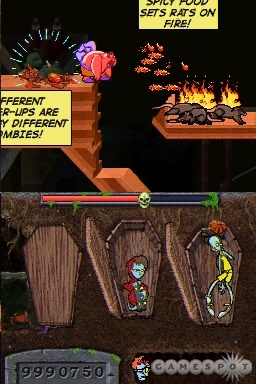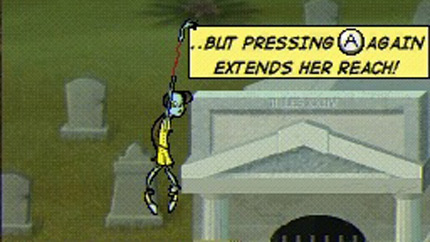In a sane world, teenage zombies wouldn't be very intimidating. They'd spend most of their daylight hours sulking in their graves, venturing forth only at night to hang around the 7-Eleven parking lot with the hope of roping older zombies into acquiring brains for them. But in a world at the mercy of invading legions of alien brain thingys, the pubescent undead become a force to be reckoned with. The voracious appetites that in life drove them to consume mass quantities of Cheez-Its and orange soda now compel them to seek out and devour as many delectable squishy brainmeats as they can. Teenage Zombies: Invasion of the Alien Brain Thingys chronicles the platforming adventures of three teenage zombies in such a world, each armed with unique powers that must be used in tandem to progress through levels. It's a cute, clever, competent game that is regrettably short-lived and not very challenging to boot.
At the beginning of the Teenage Zombies adventure, you are treated to a fully voiced intro presented in an irreverent pulp comic style. This serves to introduce the arch villain, the Big Brain, who is a vain, self-aggrandizing cerebrum with a penchant for snow globes. We also meet our zombie heroes, Zack "Half-Pipe" Boyd, Lori "Lefty" Lopez, and Finnigan "Fins" Magee. Their brain binge is chronicled between levels in the similarly styled comic book segments that are often amusing, sometimes hilarious, and definitely the most entertaining element in the game.

The action plays out on the top screen of the DS, while the bottom screen displays the resting places of the three zombies, your point total, and your "unhealth" meter. Only one of the three zombies is in action at any given time, but you can switch between them on the fly by using the shoulder buttons or by tapping their graves with the stylus. Each zombie can jump and attack (though not simultaneously) with varying degrees of proficiency. Lefty can't jump high, but her extendable arm allows her to reach ledges that the other two can't reach. Half-Pipe can jump the highest and shimmy into small passages, but his slow attack makes him a dodgy choice in a fight. Fins' jumping skills are the weakest, though he can use his tentacles to climb walls or traverse wires. His real strength lies in his potent multidirectional attack, which makes him your go-to zombie when the screen is thick with think sacs.
In addition to these unique abilities, each zombie has three specific power-ups that he or she can acquire. These lend temporary superzombie powers to your gray-matter gobblers and enable them to, for example, defeat hordes of brains with flaming vomit, cross electrified floors with monster truck tires, or deflect a cascade of debris with a colorful umbrella. Though these power-ups are mildly clever in their own right and offer a nice break from your standard abilities, they are found in such close proximity to the places you'll need to use them that they fail to add much beyond that.
In the first dozen levels, comic-style text boxes (which, amusingly, you can climb on as if they were solid) appear to school you in the appropriate application of your various skills. As you progress, these boxes appear less frequently, and the game makes more diverse demands on your platforming skills and power-up usage. Still, given the limited number of actions your decaying trio can perform, it's never much of a challenge to figure out what to do next. All three zombies move at a slow speed in keeping with the physiology of all congealed-blooded species, so the platforming action skews toward deliberately paced plodding and puzzle-solving rather than fast-paced running or precision jumping.
Many different types of brain soldiers are set against you in this epic conflict. Some brains fly around and shoot lasers, while some roll on tank treads and shoot lasers. Some eschew lasers for telekinetically thrown objects, while some take control of police officers and security guards, who in turn shoot at you (with bullets, not lasers). Most go down with one to two attacks, though this number doubles on the harder of the two difficulty modes. Even so, the challenge here is definitely light. Every brain you defeat becomes a tasty unhealth booster, and death offers no penalty other than a return to the beginning of the not-very-long level. Additionally, you can pick up loose zombie limbs throughout levels that, when assembled in a goofy limb-attaching minigame, refill your unhealth completely. A few stages toward the end are a bit trickier, but you will likely be able to finish the zombie adventure in five to six hours.

Interspersed throughout Adventure mode are stylus minigames, which, once discovered, become playable from the menu screen. These diversions are of varying quality; some could be passed off as fun, though most are a bit dull and feature twitchy controls. The only real reason to play any of them more than once is to earn a high enough total score to unlock harder levels of The Big Brain Challenge. This challenge, laid before you by the Big Brain himself, is a series of 10 quick minigames seemingly inspired by the brain game challenges that have flooded the DS market of late. Tasks include spotting the humans in a crowd of brains, remembering sequences of brains, and connecting the brains in order of size, as well as many others. If you ace a series of 10, you'll win one of the Big Brain's prized possessions, such as his childhood beanie. It's not much of an incentive, and these stylus games end up feeling like fava beans and a nice Chianti--nice to have with a meal, but everyone's really there for the main course.
All told, Teenage Zombies: Invasion of the Alien Brain Thingys is a reasonably fun game while it lasts. The cartoon-style visuals are appealing, and the platforming action is serviceable. The pervasive humor is its strongest point, but none of the same cleverness is to be found in the level designs. The price tag seems a bit steep for this lobotomized action game, but if you hunger for pulp zombie humor, it's a good snack.